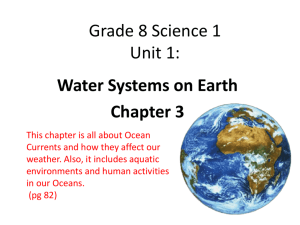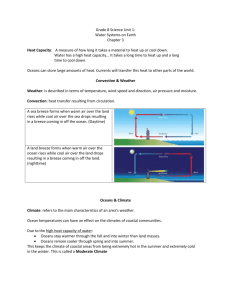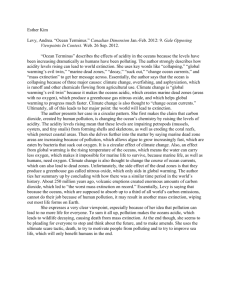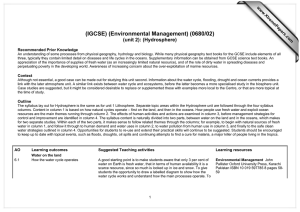chpt-3-pp-2014-number-2
advertisement
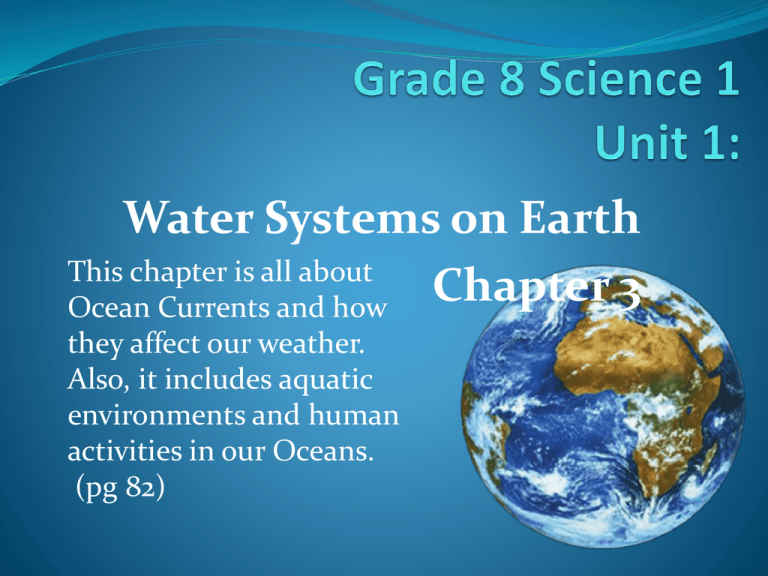
Water Systems on Earth This chapter is all about Chapter 3 Ocean Currents and how they affect our weather. Also, it includes aquatic environments and human activities in our Oceans. (pg 82) Heat Capacity A measure of how long it takes a material to heat up or cool down. Water has a high heat capacity... It takes a long time to heat up and a long time to cool down. Oceans can store large amounts of heat. Currents will transfer this heat to other parts of the world. Heat Capacity ≠ Specific Heat Capacity Convection & Weather Weather: is described in terms of temperature, wind speed and direction, air pressure and moisture. Convection: heat transfer resulting from circulation. Oceans & Climate Climate: refers to the main characteristics of an area’s weather. Ocean temperatures can have an effect on the climates of coastal communities. Due to its high heat capacity: Oceans stay warmer through the fall and into winter than land masses. Oceans remain cooler through spring and into summer. This keeps the climate of coastal areas extremely hot in the summer and extremely cold in the winter. This is called a Moderate Climate El Niño... Please write in foldable Occurs every 3-7 years The trade winds do not increase after having been slowed down. The waters are warmer than usual. El Nino is responsible for changing rainfall patterns around the world. Drought & Fire Australia Africa Central America Storms & Floods Peru Chile North America It forces phytoplankton to move deeper and fish/mammals follow. Fisher people have no fish. La Niña... Right hand side of foldable Often follows El Niño The equatorial trade winds increase allowing continuous upwelling of cooler water. La Nina is responsible for restoring rainfall patterns around the world. Floods Storms Storms &and Floods Australia Africa Central America Drought & Fire Drought & Fire Peru Chile North America Marine life flourishes as the upwelling bring nutrients for the phytoplankton. Ocean Current & Climate... Our weather patterns are rapidly changing due to the interaction of the Labrador Current and the Gulf Stream. Warm surface currents transfer tropical heat to the atmosphere and colder currents remove heat from the atmosphere. When the warm, moist air above the Gulf Stream blows over the colder water of the Labrador Current, it cools and condenses, producing fog. Newfoundland Temperature fluctuations occur rapidly in NL due to our location between warm, tropical winds moving north and cold, arctic winds moving south. Local atmospheric temperatures depend on which of these prevail. Living in Water...pg 11 Worksheet Describe species found in the following freshwater environments. Be sure to include invertebrates, vertebrates, microorganisms and plants. You can use your textbooks to look at the pictures pp 91-92 Freshwater Environments: 1. Lakes and ponds 2. Wetlands 3. Rivers and streams 4. Estuaries Refer to pages 90-93 Saltwater Environments: 1. Pelagic zone: the water column 2. Benthic zone: the ocean floor pg.10 Abiotic Factors that affect plant and animal distribution: 1.Temperature: Low temperature means more dissolved oxygen. 2.Dissolved Oxygen: Levels should be ≥ 5mg/L 3. Phosphates: levels should be < 10µg/L Pg 17 4. pH: level of acidity range should be 5-8.5 5. Turbidity: how cloudy is the water 6. Pollution 7. Upwelling: When the bottom current comes up to the surface and brings nutrients with it. 8. Salinity - (marine) 9. Ocean currents - surface and deep water current(marine) How do these factors affect productivity and species distribution in both marine and fresh water environments? Water Pollution Harmful materials released into the environment through natural or human activities. Can be DIRECT ( point source) comes from specific source INDIRECT ( non point source) comes from many different sources (# of different places pollution came from) Pollution EFFECTS of pollution – Humans are the most responsible. Most polluted areas are along coastlines where there are beaches and estuaries. The water flowing on the coastline traps the pollution Solid Waste – plastics , metals etc. Acid Precipitation Pollutants entering water system when toxic substances are released into the air. Dissolved chemicals falling from the sky Winds carry chemicals from polluted areas across land and kill plants and animals NL gets lots of acid rain from pollutants outside of province through winds. Offshore Oil Industry...p. 104 Affects on the marine environments include: 1.Oil spills 2.Drainage from cities and farms 3.Seismic testing – shock wave 4.Untreated waste disposal from factories Hibernia Platform Invasive Species When new or foreign species are introduced to existing food webs and upset the balance of that food web. Placentia Bay – Green Crab Green crab entered food web from bilge ( which collects dirty water in ships ).Dirty water entered our sea in Placentia Bay. Crab came with it. Overfishing... p. 105-6 Technologies that have contributed to overfishing include: 1.Fish finding technologies such as radar 2.Factory freezer trawlers Bottom Sea Trawling Aquaculture...p. 106-7 Definition: The growing and harvesting of marine species in a controlled marine area. Usually built in sheltered areas such as a bay. Problem: May have accidental release of organisms and spread of diseases Salmonoid Farm in Bay d’Espoir, NL
